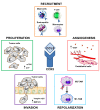Inhibition of the CCL5/CCR5 Axis against the Progression of Gastric Cancer
- PMID: 29772686
- PMCID: PMC5983686
- DOI: 10.3390/ijms19051477
Inhibition of the CCL5/CCR5 Axis against the Progression of Gastric Cancer
Abstract
Despite the progress made in molecular and clinical research, patients with advanced-stage gastric cancer (GC) have a bad prognosis and very low survival rates. Furthermore, it is challenging to find the complex molecular mechanisms that are involved in the development of GC, its progression, and its resistance to therapy. The interactions of chemokines, also known as chemotactic cytokines, with their receptors regulate immune and inflammatory responses. However, updated research demonstrates that cancer cells subvert the normal chemokine role, transforming them into fundamental constituents of the tumor microenvironment (TME) with tumor-promoting effects. C-C chemokine ligand 5 (CCL5) is a chemotactic cytokine, and its expression and secretion are regulated in T cells. C-C chemokine receptor type 5 (CCR5) is expressed in T cells, macrophages, other leukocytes, and certain types of cancer cells. The interaction between CCL5 and CCR5 plays an active role in recruiting leukocytes into target sites. This review summarizes recent information on the role of the CCL5 chemokine and its receptor CCR5 in GC cell proliferation, metastasis formation, and in the building of an immunosuppressive TME. Moreover, it highlights the development of new therapeutic strategies to inhibit the CCL5/CCR5 axis in different ways and their possible clinical relevance in the treatment of GC.
Keywords: CCL5; CCR5; CCR5 antagonists; gastric cancer; invasion; tumor microenvironment.
Conflict of interest statement
The authors declare no conflict of interest.
Figures


Similar articles
-
The potential to target CCL5/CCR5 in breast cancer.Expert Opin Ther Targets. 2014 Nov;18(11):1265-75. doi: 10.1517/14728222.2014.949238. Epub 2014 Sep 26. Expert Opin Ther Targets. 2014. PMID: 25256399 Review.
-
Cytokine CCL5 and receptor CCR5 axis in glioblastoma multiforme.Radiol Oncol. 2019 Nov 20;53(4):397-406. doi: 10.2478/raon-2019-0057. Radiol Oncol. 2019. PMID: 31747383 Free PMC article. Review.
-
The inflammatory chemokine CCL5 and cancer progression.Mediators Inflamm. 2014;2014:292376. doi: 10.1155/2014/292376. Epub 2014 Jan 2. Mediators Inflamm. 2014. PMID: 24523569 Free PMC article. Review.
-
Down-regulation of KLF5 in cancer-associated fibroblasts inhibit gastric cancer cells progression by CCL5/CCR5 axis.Cancer Biol Ther. 2017 Oct 3;18(10):806-815. doi: 10.1080/15384047.2017.1373219. Epub 2017 Sep 21. Cancer Biol Ther. 2017. PMID: 28934010 Free PMC article.
-
CCR5-Mediated Signaling Is Involved in Invasion of Glioblastoma Cells in Its Microenvironment.Int J Mol Sci. 2020 Jun 12;21(12):4199. doi: 10.3390/ijms21124199. Int J Mol Sci. 2020. PMID: 32545571 Free PMC article.
Cited by
-
A Prognostic Signature Based on Immunogenomic Profiling Offers Guidance for Esophageal Squamous Cell Cancer Treatment.Front Oncol. 2021 Feb 24;11:603634. doi: 10.3389/fonc.2021.603634. eCollection 2021. Front Oncol. 2021. PMID: 33718151 Free PMC article.
-
Tumor-Associated Macrophages as Major Immunosuppressive Cells in the Tumor Microenvironment.Cancers (Basel). 2024 Oct 8;16(19):3410. doi: 10.3390/cancers16193410. Cancers (Basel). 2024. PMID: 39410029 Free PMC article. Review.
-
Oncofetal reprogramming in tumor development and progression: novel insights into cancer therapy.MedComm (2020). 2023 Dec 2;4(6):e427. doi: 10.1002/mco2.427. eCollection 2023 Dec. MedComm (2020). 2023. PMID: 38045829 Free PMC article. Review.
-
Identification of the hub genes and transcription factor-miRNA axes involved in Helicobacter pylori-associated gastric cancer.Oncol Lett. 2022 Mar;23(3):89. doi: 10.3892/ol.2022.13209. Epub 2022 Jan 21. Oncol Lett. 2022. PMID: 35126731 Free PMC article.
-
A functional interaction between the CCR5 and CD34 molecules expressed in hematopoietic cells can support (or even promote) the development of cancer.Hematol Transfus Cell Ther. 2020 Jan-Mar;42(1):70-76. doi: 10.1016/j.htct.2019.10.001. Epub 2019 Nov 29. Hematol Transfus Cell Ther. 2020. PMID: 31822447 Free PMC article.
References
Publication types
MeSH terms
Substances
LinkOut - more resources
Full Text Sources
Other Literature Sources
Medical
Research Materials
Miscellaneous

